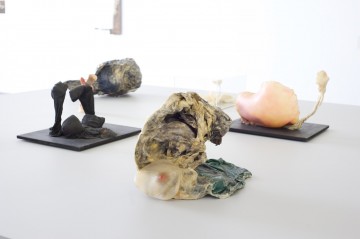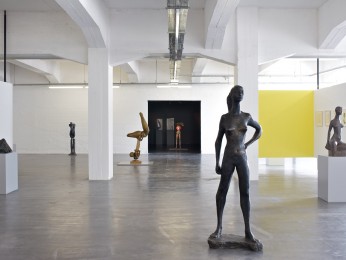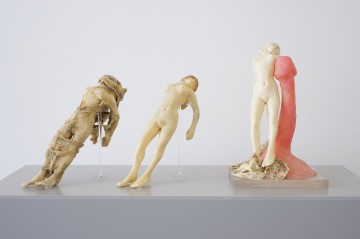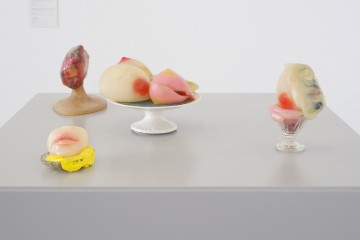ADAM MAZUR: When did you become interested in Alina Szapocznikow?
JOANNA MYTKOWSKA: It’s difficult to piece the timeline back together after all these years. Like every Polish art historian, I certainly grew up in the shadow of her legend. I was enormously impressed with her 1998 retrospective at the Zachęta.
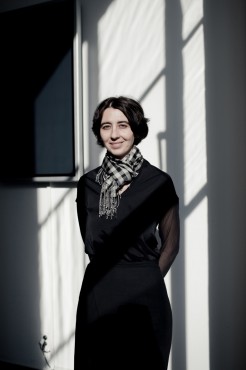 Joanna Mytkowska
Joanna Mytkowska
photo: Maciej LandsbergWhat surprised me at the time was that her fame was limited to Poland, and I decided to explore that subject once I became an museum director. It seemed worthwhile to try to translate our greatest artists into an international language, and I thought that would be the right objective for the new museum in Warsaw. Thanks to my international experience, I knew just how to do it.
But I have to come clean about one thing: I’m interested in Alina Szapocznikow as the director of an institution that has its own cultural policy. My contribution isn’t new research — although, as an institution, we’ve certainly initiated new studies. I’ve proposed a new way of presenting the work of Alina Szapocznikow within the context of contemporary art history.
Before you become the director of the Museum of Modern Art in Warsaw, did you draw on your professional experience in your work on Szapocznikow?
Prior to joining the Museum, I worked at the Centre Pompidou, where one of my main responsibilities was to consult on the purchase of pieces for the collection. As it turned out, Szapocznikow — who had been living in Paris for ten years — was absent from France’s public collections.
Joanna Mytkowska
Joanna Mytkowska, born 1970, is an art critic, art historian, and curator. In 2007 she was appointed director of the Museum of Modern Art in Warsaw. She is a co-founder of the Foksal Gallery Foundation, an organisation created to study and document the work of the Foksal Gallery, of which Mytkowska was a part in the 1990s. In 2005 Mytkowska served as the curator of the Polish Pavilion at the Venice Biennale, before joining the Centre Pompidou as a curator in 2006–2007.
Literally a single piece had been bought in the 50s by the Musée d’Art Moderne de la Ville de Paris (First Love), and that was it. Szapocznikow’s international museum presence started with the Centre Pompidou’s purchase of original prints from the 1971 Photosculptures series. The curators of the Pompidou’s photography section and I drove to the Paris apartment where Piotr Stanisławski — the artist’s son — lived, to verify the authenticity of the pictures, which we then bought and displayed at Documenta 12 in Kassel shortly after. That purchase in 2008 was the first in a series of similar acquisitions.
Did you have any direct encounters with Szapocznikow’s work in your professional career here in Poland?
There was one event in 2004, when we were working on an exhibition titled Prym at the BWA in Zielona Góra. Andrzej Przywara and I employed the strategy of juxtaposing historical pieces with work by contemporary artists in order to explore the changes that have occurred in how exhibitions are designed in modern spaces in general, and in this particular space in Zielona Góra. Anke Kempkes, the curator of Kunsthalle Basel, came to see the exhibition, and she later included work by Szapocznikow in a show for young artists titled Flesh at War with Enigma in Basel.
How did Szapocznikow fit into the program of the Museum of Modern Art?
When we commenced work on the museum, Alina Szapocznikow was an artist whose oeuvre had already been thoroughly analysed. Jola Gola had studied her for over twenty years as the curator of the Academy of Fine Arts Museum in Warsaw. She put in an enormous amount of work. Then there were studies by art historians belonging to the so-called “Poznań School”, who used a gender studies approach to her work. Agata Jakubowska had already written Portret wielokrotny dzieła Aliny Szapocznikow [A Multiple Portrait of the Work of Alina Szapocznikow]. The Only thing missing was the international context.
We worked on the exhibition as a team. By sheer coincidence, all of us happened to be women. Agata Jakubowska played a very important role, and she was the one who suggested the title, Niezgrabne przedmioty / Awkward Objects, taken from Szapocznikow’s 1972 manifesto. We new by that time — largely thanks the work of young artists such as Paulina Ołowska — that Szapocznikow’s oeuvre can be read in a very contemporary way. By inviting international artists such as Louise Bourgeois, Eva Hesse, Pauline Boty, and Maria Bartuszova to take part in the exhibition, we were pointing out the similarities between them, while emphasising Szapocznikow’s originality. The show at the Museum of Modern Art was a groundbreaking event in terms of the interpretation of her work, while the presentation at the WIELS Centre for Contemporary Art in Brussels elaborates on the those interpretative ideas.
So what was Awkward Objects about?
It portrayed Szapocznikow as an artist who wanted to remain true to her own experience by following her path from classical sculpture to the dematerialisation of art via pioneer experiments in form. She transcended the art of her day because here language became insufficient for what she wanted to express. Whether the solitude of her experience was a result of the effort involved in expressing the trauma of war, or her faithfulness to her individual experience as a woman, or a universal convergence of the opposites that rule our lives, that is, love and death, is a question of study and interpretation. That’s still up for debate. But I think we managed to capture that path, that turn towards risk and the unknown.
Szapocznikow ceased to be a great Polish sculptor?
Precisely. Tearing down that cliché gave her the chance to become a great 20th century artist. In her 1972 manifesto, she herself writes that all she does is make awkward objects, and that the concept of sculpture has become irrelevant to her. And that is an extraordinarily modern notion.
How did that shift in Szapocznikow’s position work out institutionally?
The groundbreaking moment came when Maria Matuszkiewicz catalogued the artist’s entire archives and posted them on the museum website, which was possible thanks to the invaluable assistance of the artist’s family, particularly Piotr Stanisławski. People still comment on how extraordinary it is to find an exhaustive catalogue of the work of such an artist as Szapocznikow. The next piece of the puzzle was the participation of world-renowned scholars in the conference devoted to the exhibition, and their interest in Szapocznikow as an artist. That was largely the work of Marta Dziewańska, the curator of the museum. We managed to invite Griselda Pollock. We also tied Szapocznikow into the research conducted by Georges Didi-Huberman, who studied the concept of the imprint in art, and organised an extensive exhibition at the Centre Pompidou titled L’empreinte. The museum later published the book Alina Szapocznikow. Awkward Objects, which contained the papers presented at the conference. From the very beginning, the assumption was that our work would culminate in a retrospective exhibition similar to the one currently running in Brussels.
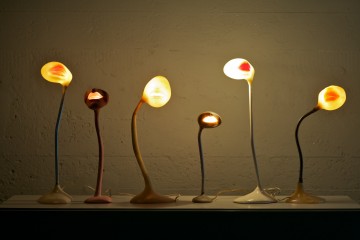 Lamps, 1966, WIELS Contemporary Art Centre,
Lamps, 1966, WIELS Contemporary Art Centre,
Brussels, 2011
photo: Filip Vanzieleghem
If Awkward Objects was a groundbreaking exhibition, and the Sculpture Undone show at the WIELS doesn’t add anything new, then why haven’t you taken Awkward Objects to new venues?
Awkward Objects was unsuited for travel. It was designed to challenge the way we traditionally think about Szapocznikow in Poland, where she was a very famous artist, but nevertheless one fixed in a certain local context. We wanted to demonstrate other ways of interpreting her work, showing that there are other artists with a similar story, that there is such a thing as a history of feminist art, a history of women who had trouble with expression — that was the point of the exhibition. But there’s no point in doing that outside Poland. Our problem was that Alina Szapocznikow’s art was being read almost exclusively from the perspective of her unique biography, in isolation from the international history of art.
One the other hand, we’ve always been interested in doing a broad, new retrospective, and we were aware that she was an artist who belonged in world art history. We started conducting difficult negotiations with Western museums, for example the Musée d’Art Moderne in Paris, which ended up rejecting our offer. Then it turned out that the Szapocznikow exhibition would go to the Museum of Modern Art in New York City following the show in Brussels.
Alina Szapocznikow. Sculpture Undone
The exhibition by Joanna Mytkowska and Elena Filopivic runs until 8 January, 2012 at the WIELS Centre for Contemporary Art in Brussels. It is the first exhaustive presentation of the sculptor’s work outside Poland. The exhibition focuses on pieces from her late and most experimental period, ended by her premature death in 1973. Szapocznikow developed a highly individual formal language and a personal narrative that is manifested in her provocative and corporal pieces, which occupy a hard-to-define area between surrealism, new realism, and pop art. Such pieces as polyester casts of body parts made into everyday objects and sculpture collages with embedded family photographs have led critics to hail Szapocznikow as a precursor to the feminist and conceptualist approach to sculpture. After Brussels, the travelling exhibition will be featured at the MOMA in New York and other cities.
Alina Szapocznikow. Sculpture Undone expands on Awkward Objects (2009), held by the Museum of Modern Art in Warsaw. The latter exhibition featured work by Szapocznikow alongside pieces by other internationally-renowned artists: Maria Bartuszova, Pauline Boty, Louise Bourgeois, Eva Hesse, and Paulina Ołowska. The show was intended to illustrate shifts in perception of the artist’s legacy.
This raises the question of cultural policy during the Polish presidency in the EU.
The Alina Szapocznikow exhibitions in Brussels received a generous grant from the Adam Mickiewicz Institute which covered about a quarter of the total costs. Cultural policy played a great role in making this project happen. The exhibition falls under cultural policy, even though it’s largely focused on studying a particular artist, rather than being a topical “Art from Poland” type of show.
How did your collaboration with the WIELS Centre for Contemporary Art come about?
The WIELS is a similar institution to ours. It has to fight hard to maintain its status in Brussels and Belgium, because even though the field of contemporary art is much more developed over there than it is here — with a greater audience, and more collectors and galleries — there’s still no leading institution when it comes to new ideas. WIELS is the only institution, aside from the MHKA in Antwerp, with the ambition to shape new values in modern art. The WIELS collaborates with two artist in particular: Francis Alÿs — who deals exclusively with the centre in Belgium — and Luc Tuymans, who expressed his support with a big solo exhibition. That’s why the WIELS was interested in Szapocznikow’s experimental and pioneering approach, despite the significant cost involved in hosting this historic exhibition.
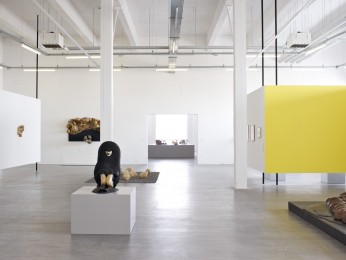 Pieces on display. WIELS Contemporary Art Centre,
Pieces on display. WIELS Contemporary Art Centre,
Brussels, 2011
photo: Filip Vanzieleghem
It’s no accident that the exhibition is heading off to the United States after the WIELS show. How did you manage to do that?
Szapocznikow is enjoying a growing presence on the American art market. That’s a factor that makes it at once easier and more challenging to do our job. The sculptures are highly valuable, rare, and increasingly expensive to display. On the other hand, there’s much greater interest among collectors as well as audiences. They’re all very supportive. The artist’s high prestige on the art market made it much easier to organise exhibitions in the US.
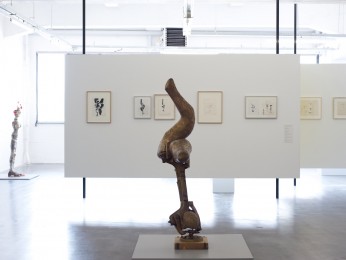 Pieces on display. WIELS Contemporary Art Centre,
Pieces on display. WIELS Contemporary Art Centre,
Brussels, 2011
photo: Filip Vanzieleghem
Could you tell us about the exhibition Alina Szapocznikow. Sculpture Undone 1955–1972 itself? It’s not a typical museum retrospective.
You’re right. But before I tell you about the layout of the exhibition, let me start by saying that it was prepared with an audience in mind that had never heard about Alina Szapocznikow. That was our assumption. We weren’t interested in her whole biography, but in telling the story of an experiment, the story of an artist who started with a classic academic background, classical sculpture, and went on to practice its complete refutation, the dematerialisation of the art object, leaving just the remains, just the imprint. We also emphasise that hers was not a path that followed the main trends in art; it was a completely separate path.
The exhibition occupies two storeys of the former brewery that now houses the WIELS. The first room contains all the sculptures created between 1955 and 1965. We point out the significance of the political thaw that was taking place in Poland at the time, and the resulting experiment on which Szapocznikow then embarked. This part of the exhibition ends with pieces created during her mature phase in Paris, where she settled after leaving Poland in 1963. As you enter the first room, you can scan all the important sculptures at once. It was important to us that people could see it as a kind of whole. There you have Difficult Age and First Love, as well as Nude, Goldfinger, and Man with the Instrument. The sculptures are always accompanied by carefully selected drawings. Out of the 600 drawings produced by Szapocznikow in her lifetime, we’ve selected 40. Some of the drawings are studies, some are sketches illustrating the development of the idea behind a sculpture. The drawings on display always emphasise the character of a given stage in her artistic career, whether it’s her interest in organic abstraction, or the mutation of form.
The drawings play a similar role to the disegno in the Renaissance: they illustrate the idea behind the sculpture, the conceptual work that precedes the manual execution. What I also found interesting was that the drawings made it unnecessary to provide description. Obviously, we’ve provided a guide to the exhibition, but I hope that the drawings subtly accentuate the timeline and Szapocznikow’s evolution as an artist.
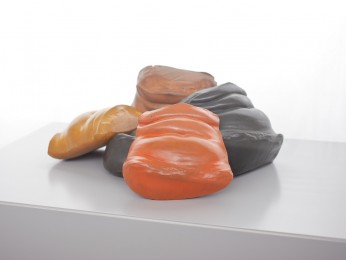 Belly Cushions, 1968. WIELS Contemporary Art Centre,
Belly Cushions, 1968. WIELS Contemporary Art Centre,
Brussels, 2011
photo: Filip Vanzieleghem
The first floor of the exhibition ends with a small, dark room that contrasts with the brightness and modern style of the main room.
Yes, I have my doubts as to whether or not that one room should have been set up differently, whether it turned out too theatrical. The pieces on display are made of polyester and are equipped with lights, such as the illuminated Sculpture-Lamp, Illuminated, and Caprice. There is also a screening of the beautiful 1976 film by Hanna Włodarczyk, Mark, an impressionist, poetic illustration of Szapocznikow’s sculpting style. The room accentuates the weirdness and grotesqueness of the pieces and their gloomy, surrealist nature.
And on the second floor…
The higher, more monumental room upstairs opens by emphasising the artist’s later fascination with formlessness, beginning with the black drip sculptures in which there is a strong random element and in which the matter drives the shape. This excellent selection was made possible by a loan from the National Museum in Wrocław, which has a large collection of pieces from the 1960s. Here we repeated a technique we used at our Warsaw exhibition, namely the juxtaposition of her two most experimental sculptures: Sous la coupole and Siège-piège, which operate through purely abstract form and soft, organic material, and in which there is no cast of the body or reference to any recognisable world. We displayed these pieces along with sculptures by Louise Bourgeois in Warsaw, but they can be interpreted as discussion of formlessness just as well as a critique of American minimalism, mainstream art — a largely male-dominated field to which Szapocznikow could not aspire. We also managed to borrow seven of the nine Fetishes and display them together on one riser. They’re accompanied by Desserts, The Bachelor’s Ashtray, and studies of Mad White Fiancée. The exhibition ends with Herbarium and Piotr: a lofty conclusion. These ambiguous pieces might even be described as alluding to Christian iconography, the vera icon. On the other hand, the titular Piotr is portrayed in a state of levitation, half-way between ecstasy and fainting, or, according to an interpretation by Paweł Leszkowicz, between death and orgasm. That is also Szapocznikow’s last piece (1972) and an excellent conclusion to the artist’s complex, contradictory oeuvre.
That would be the end of the exhibition, but there’s a separate, archival space on the third and last floor of the WIELS.
Yes, the archives and narratives of the artist’s life have been clearly separated from the rest of the exhibition. We divided this presentation into several themes that didn’t make it into the exhibition, such as: the soc-realist period, formal experiments, the artist’s self-image, unrealised projects, and public projects. This part also features the only TV documentary devoted to Szapocznikow, by Francois-Marie Drota.
How was the exhibition received? You portray Szapocznikow as a solitary artist, but is she really that original when compared to other artists of the period?
While the exhibition has been well received — and was given a good review by Le Monde, for instance — some have pointed out that there are many such forgotten artists, and that perhaps we should devote similar exhibitions to them. But it seems that Szapocznikow’s work is characterised by a special tension between sensuality and darkness that remains fascinating and allows us to interpret in in a modern way.
translated by Arthur Barys


